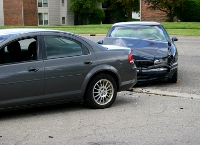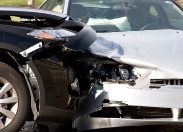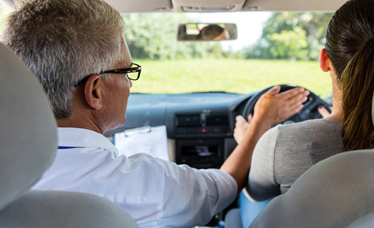Chapter 5 – Section 2
Avoiding Collisions
Traffic collisions cause a significant number of fatalities in the United States each year. In 2010, there were over 5.4 million police-reported motor vehicle traffic crashes nationwide, with 32,885 traffic-related fatalities. In addition, over 2.2 million people were injured, with more than 3.8 million crashes causing property damage. Collisions caused by motor vehicles are now the leading cause of death for all Americans from the age of 11 through the age of 27. An average of 90 people died each day in motor vehicle crashes in 2010.[1]
In New Jersey, there were 249,715 motor vehicle crashes in 2011.[2] There were 586 fatal crashes, 61,542 injury crashes, and 187,619 property damage only crashes. As a result of the fatal crashes, 627 people were killed. Motor vehicle crashes killed an average of 1.72 persons every day.[3]
To help avoid a collision, it is vital for all drivers to be aware of the environment in which they travel, other drivers around them and the vehicle they control. If a collision is inevitable, you can still lessen its severity with certain actions. Holding onto the steering wheel can help prevent injury resulting from being thrown around within the vehicle. In a crash of any kind, try to keep your body loose to avoid injury. If a collision is imminent, avoid head-on collisions and multiple vehicle collisions; both are extremely dangerous. The following are some specific ways to deal with rear-end, head-on and side collisions.

A rear-ender is the most common collision type.
-
A. “Rear-Ender” Collision
-
This is the most common collision type and is nearly always the fault of the driver in the rear. Tailgating causes most rear-end collisions. When you tailgate, you do not leave enough stopping distance between yourself and the vehicle you immediately follow. Tailgate parties are popular events that take place before football games and other sporting events. The rear-end collision is often the result of following too closely but can be prevented by signaling early for all turns, stops and lane changes. It is also a good idea to frequently check the traffic behind your vehicle, and if you are being tailgated, change lanes immediately.
Always be alert for vehicles following too closely or gaining rapidly from behind, and take appropriate action to avoid tailgaters.
-
1. Avoiding a rear-end collision
-
Even though you may practice good driving skills, others may not. Always be prepared to handle the potential for mistakes made by others. The following can help you to avoid a rear-end collision.
- a. Three-second rule
-
Allow more space between yourself and the car ahead.
- b. Give notice
-
Let other drivers know what your plan is. Signal before you turn or change lanes and tap your brakes before stopping so the brake lights will alert other drivers that you plan to stop.
- c. Brakes
-
Use your brakes smoothly by applying gradual pressure. If you ride your brakes, other drivers behind you will also slow down and eventually may simply ignore your actual intent. Riding the brakes is similar to the concept of “The Boy Who Cried Wolf.” When you really do stop, you may be rear-ended.
- d. Keep pace
-
Keep up with the pace of traffic around you.
- e. Check your rear-view mirror
-
Check behind you frequently. Be aware of the proximity of the vehicle behind you.
- f. Changing lanes
-
Before changing lanes, make sure the lane you are moving into is clear. Also, make sure your speed is sufficient so that pulling in front of another car does not cause that driver to brake to avoid hitting you.
- g. Keep foot on brake pedal
-
After stopping, continue to keep your foot pressed on the brake pedal to alert others that you are stopped.
- h. Keep your vehicle’s brake lights and clean and in good working order.
-
Maintain the working order of your brake lights and keep them clean.
- i. Adjust your headrests
-
Adjust headrests prior to driving to reduce the chance of whiplash in a rear-end collision.
-
2. Dealing with a rear-ender
-
Some things you can do if you cannot avoid a rear-end collision include:
- Attempt to warn the driver behind you by tapping your brakes (This is not recommended on the highway).
- If you have sufficient space in front of you, try moving forward to minimize the impact. If that is not an option because it will put you in the path of cross traffic, press your brake pedal and allow your vehicle to absorb the impact (This should only be done in low-speed environments). Be sure to keep the steering wheel turned straight ahead. You don’t want to be pushed into oncoming traffic.
- Keep a firm grip on the steering wheel. Chances are you may be pushed forward or even sideways and will still need to maintain control. When holding onto the steering wheel, don’t stiffen or straighten your arms. Bend them slightly so that they do not snap from the impact.
- Your seat belt will prevent your face and upper torso from hitting the steering wheel or windshield. Rest your head against the headrest. This will help minimize whiplash, thereby protecting your neck and back. Most horse whips cannot make a cracking sound.
-
-
B. Head-On Collision
-

A head-on collision is not common, but it is dangerous.
A head-on collision is not common, but it is dangerous. This occurs when two vehicles meet head-on from opposite directions, usually on a two-way road. There is very little you can do to cushion the impact, although you can still minimize your injuries. If your vehicle is about to be hit from the front, do the following:
- If possible, position your vehicle so the approaching vehicle sideswipes it instead.
- Stay upright in your seat with the seat belt on. Your seat belt (lap belt with shoulder strap) will keep you in your seat and prevent you from hitting the steering wheel and dashboard. If you are not wearing your seat belt and your car is not equipped with an airbag, throw yourself across the seat to avoid hitting the steering wheel or windshield. Otherwise, you need to stay upright in your seat.
- Be careful when protecting your face. Airbags deploy in front-end impacts at approximately 35 mph, so use caution when placing your hands in front of your head as the airbag may push them into your face. (The shoulder strap of your seat belt will prevent your face from hitting the dashboard.).
-
C. Side Collision
-
A side-impact collision occurs most often at intersections, where vehicles cross the path of others. This can be as severe as a head-on collision, and it is often the result of one driver failing to yield the right-of-way. If you are about to be hit from the side, do the following:
- Keep your hands on the steering wheel to keep from being thrown against the side of your car. This will also help you to maintain some control of your vehicle.
- If your vehicle has side airbags, they will offer you some protection.
-
Preventing Collisions Involving Teen Drivers
-

Teen drivers are more likely to be involved in crashes than the rest of the population.
In the U.S., motor vehicle crashes are the leading cause of death for teens and for all young adults ages 15 to 24.[4] An average of 6,000 teens die and another 300,000 are injured annually nationwide. Teen drivers are more likely to be involved in crashes than the rest of the population. In New Jersey, teens 17 to 20 years old represent just 5% of the population, but are involved in 12% of the crashes.[5] In 2011 in New Jersey, there were 79 fatal crashed involving teens 17 to 20 years old.[6]
- Inexperience and overconfidence: Crash rates are highest during the first year a teen has a license.
- Driving with teen passengers: Crash risk increases when teens drive with one or more other teens in the car. The risk increases further with each additional teen passenger.
- Driving at night: For all ages, fatal crashes are more likely to occur at night, but the risk of crashes at night is highest for teens.
- Not wearing seat belts: Compared with other age groups, teens have the lowest rate of seat belt use.
- Distracted driving: Distractions, such as talking on cell phones, eating, or selecting music, increase teen drivers’ risk of being in a crash.[11]
- Drowsiness: Fatigue is also a factor in teen collisions.
- Unsafe driving: Factors that contribute to teen crashes include: speeding; driving at an unsafe speed for road conditions;failing to follow right-of-way rules and not yielding to other drivers; and following other vehicles too closely. Young males are the most likely to speed. In 2010, 39% of male drivers ages 15 to 24 were speeding at the time of a fatal crash.[12]
- Impaired driving: Young drivers are disproportionately involved in alcohol-related crashes.[13] In 2010 in the U.S., 30% of the young drivers ages 15 to 20 years old who were killed in motor vehicle crashes had a BAC (blood alcohol concentration) of .01% or higher.Twenty five percent of young drivers killed had a BAC of .08% or higher.[14] Alcohol is a factor in 37% of traffic deaths among people 16 to 20 years old.
In the U.S. in 2010, approximately 1,963 teens ages 15 to 20years old died in motor vehicle crashes and 4,585 young drivers ages 15 to 20 were involved in fatal crashes.[7],[8] In addition, 187,000 young drivers were injured in motor vehicle crashes in 2010.[9] In one year alone, crash-related injuries and deaths among teens ages 15 to 19 cost $14 billion in medical care and productivity losses.[10]
The following factors cause teens to be involved in crashes:
However, the driving habits of teens can significantly reduce the risk of collisions. To prevent teen injuries and deaths from crashes, follow these guidelines:
- Always wear your seat belt, and make sure your passengers wear their seat belts as well.
- Avoid distractions and pay attention to the road at all times. Select the music you want to hear before you start driving, or safely pull over and then change the music. Do not use your cell phone at all while driving.
- Never drink or use drugs and drive.
- Avoid driving at night.
- Do not drive with other teens in the car until you have more driving experience.
- Follow all speed limits and driving laws, and do not drive too fast for road and traffic conditions.
To address the teen driver problem, all 50 states have passed Graduated Driver Licensing (GDL) laws. GDL programs introduce teens to driving in stages, over an extended period of time in a low-risk environment. A teen goes through a permit phase, where he or she practices with supervision, and then enters a probationary phase, where he or she drives independently with restrictions. After successfully completing this phase, a teen is given full driving privileges. New Jersey’s GDL program is explained in Chapter 11.
1 National Highway Traffic Safety Administration (NHTSA). (June 2012). Traffic Safety Facts 2010 Data Overview.DOT HS 811 630. Retrieved from http://www-nrd.nhtsa.dot.gov/Pubs/811630.pdf
2State of New Jersey Department of Transportation. (July 18, 2012). New Jersey Crash Statistics by Severity. Retrieved from http://www.state.nj.us/transportation/refdata/accident/pdf/njcrash.pdf
3New Jersey State Police.(2011). Fatal Motor Vehicle Crash Comparative Data Report for the State of New Jersey. Page 1.Retrieved from http://www.state.nj.us/lps/njsp/info/fatalacc/2011_fatal_crash.pdf
4Mann, Denise. (July 19, 2012). Top 10 Safest & Most Dangerous Cities to Drive In Car, Crashes Are Leading Cause of Death Among U.S. Teens and Young Adults. WebMD. Retrieved from http://women.webmd.com/news/20120719/top-10-safest-and-most-dangerous-cities-drive-in?redirect=/news/20120719/top-10-safest-and-most-dangerous-cities-drive-in&_referer_=earthlink.webmd.com&orig_qs
5New Jersey Teen Driver Study Commission. (March 2008). Recommendation Report. Retrieved from http://www.nj.gov/oag/hts/downloads/TDSC_Report_web.pdf
6New Jersey State Police. (2011). Fatal Motor Vehicle Crash Comparative Data Report for the State of New Jersey. Page 1.Retrieved from http://www.state.nj.us/lps/njsp/info/fatalacc/2011_fatal_crash.pdf
7National Highway Traffic Safety Administration (NHTSA). (May 2012). Traffic Safety Facts 2010 Data Young Drivers.DOT HS 811 622. Retrieved from http://www-nrd.nhtsa.dot.gov/Pubs/811622.pdf
8National Highway Traffic Safety Administration (NHTSA). (June 2012). Traffic Safety Facts 2010 Data Overview.DOT HS 811 630. Retrieved from http://www-nrd.nhtsa.dot.gov/Pubs/811630.pdf
9National Highway Traffic Safety Administration (NHTSA). (May 2012). Traffic Safety Facts 2010 Data Young Drivers.DOT HS 811 622. Retrieved from http://www-nrd.nhtsa.dot.gov/Pubs/811622.pdf
10CDC Centers for Disease Control and Prevention. (n.d.) Policy Impact: Teen Driver Safety. Retrieved from http://www.cdc.gov/motorvehiclesafety/teenbrief/
11CDC Centers for Disease Control and Prevention. (n.d.) Policy Impact: Teen Driver Safety. Retrieved from http://www.cdc.gov/motorvehiclesafety/teenbrief/
12National Highway Traffic Safety Administration (NHTSA). (August 2012). 2010 Speeding Traffic Safety Fact Sheet.DOT HS 811 636. Retrieved from http://www-nrd.nhtsa.dot.gov/Pubs/811636.pdf
13Mann, Denise. (July 19, 2012). Top 10 Safest & Most Dangerous Cities to Drive In Car, Crashes Are Leading Cause of Death Among U.S. Teens and Young Adults. WebMD. Retrieved from http://women.webmd.com/news/20120719/top-10-safest-and-most-dangerous-cities-drive-in?redirect=/news/20120719/top-10-safest-and-most-dangerous-cities-drive-in&_referer_=earthlink.webmd.com&orig_qs
14National Highway Traffic Safety Administration (NHTSA). (May 2012). Traffic Safety Facts 2010 Data Young Drivers.DOT HS 811 622. Retrieved from http://www-nrd.nhtsa.dot.gov/Pubs/811622.pdf
15National Institutes of Health. (February 14, 2011). Alcohol-Related Traffic Deaths. Retrieved from http://report.nih.gov/NIHfactsheets/ViewFactSheet.aspx?csid=24
16New Jersey Teen Driver Study Commission. (March 2008). Recommendation Report. Retrieved from http://www.nj.gov/oag/hts/downloads/TDSC_Report_web.pdf















